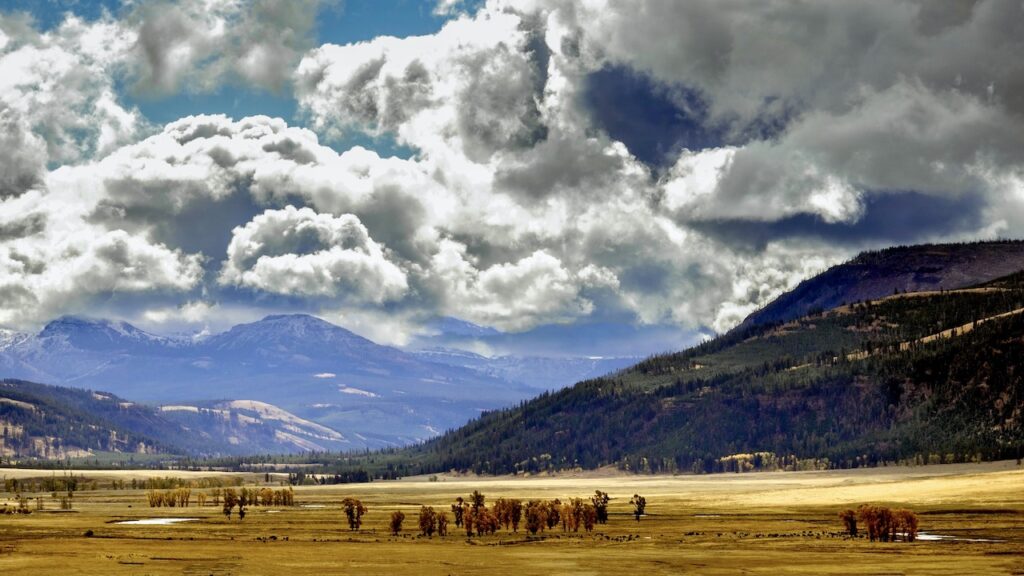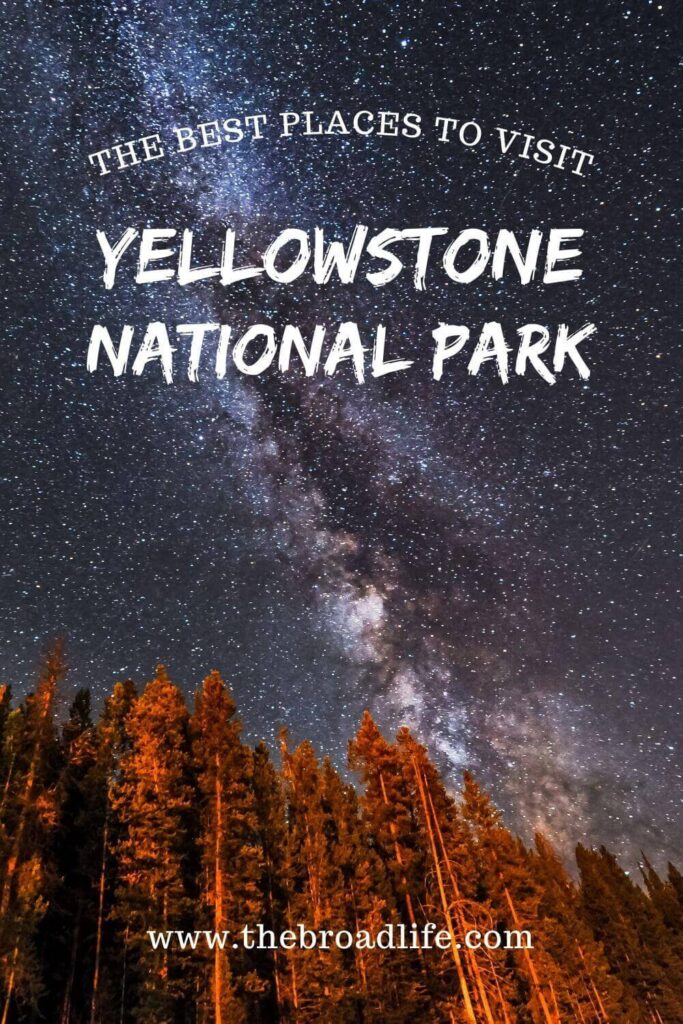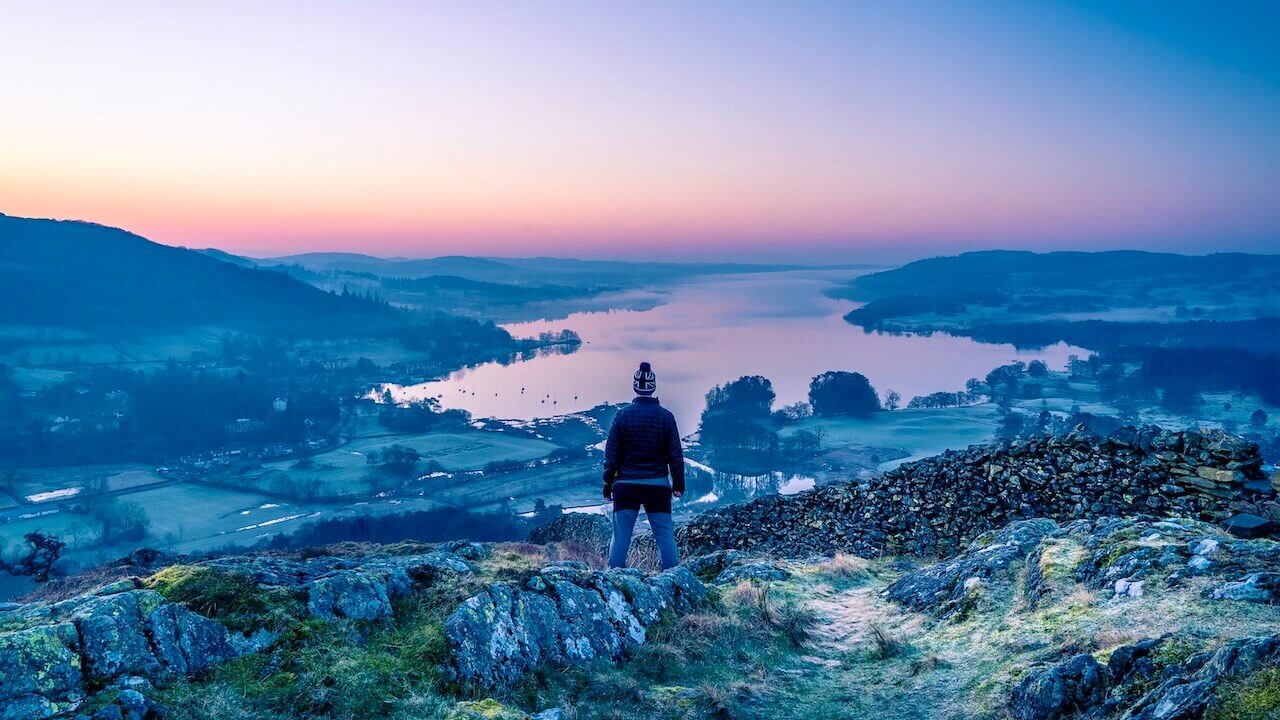
Best Places to Visit in Yellowstone National Park
There are many places to visit in Yellowstone National Park. Indeed, the world-renowned Yellowstone National Park, established in 1872, is one of the most popular tourist destinations in the United States. Stretching across the basalt plateau in the northwest corner of Wyoming, this beautiful wilderness spills over into neighboring Idaho and Montana and forms the heart of the Great Yellowstone Ecosystem, one of the largest survival and most protected tropical ecosystems in the world. Especially, the park is well-known for its breathtaking scenery, diverse flora and fauna, and fascinating geothermal wonder. Yellowstone has the world’s largest number of active geysers and provides a window into the powerful forces deep beneath the earth’s crust. That behemoth forces shape this park and dazzling, impressive landscape. Yellowstone’s landscapes range from snaking rivers and wide green valleys to canyons, vast lakes, thundering waterfalls, and screeching lunar-like landscapes.
Yellowstone is a land of contrasts. Each season paints a dramatically different scene. From the lush and sparkling greens of spring and summer when herds of bison and elk graze along the riverbanks; then the red, orange, and yellow glow when black bears feed on berries; to the white wasteland of the cold winter. Any time of year, Yellowstone National Park is a reminder of the awe-inspiring wilderness and rich wildlife that once covered our planet. On top of that, it offers an unforgettable safari adventure in the domain of Wild West America.

The Best Places to Visit in Yellowstone National Park
The best way to explore Yellowstone National Park is to drive around the Grand Loop. It’s a 142-mile trail that curves around in an eight through the park’s most striking natural features. At each attraction, well-maintained boardwalks and hiking trails provide close-up views of the main features, as well as breathtaking viewpoints and numerous trails suitable for wheelchairs. Driving the full length of the loop can take between four and seven hours, depending on the traffic. During the summer months, traffic jams can stop you from going all the way.
If you only have one day to see the park, the best approach is to explore half of the Grand Loop. Better still, if you’re in Jackson Hole, Wyoming, you can pin the park’s highlights and learn about its fascinating geology and ecology on a tour of Yellowstone National Park from Jackson. This full-day coach tour saves you the hassle of driving so you can focus on the wildlife and jaw-dropping scenery. It includes convenient hotel pick up and drop off as well as a professional guide.
If you’re taking a self-drive tour of the park, an example of the Grand Loop tour below begins at Old Faithful, near the park’s south entrance, continues far north of the loop, and ends near the same point on the south side. You can adjust the order of attractions depending on time constraints and which of the five entrances you use to enter the park.
1. Old Faithful

One of Yellowstone’s stellar attractions, the geyser known as Old Faithful is named for the periodicity it erupts, capturing columns of water high into the air. Today, witnessing this incredible sight is one of the most popular things to do in Yellowstone National Park, although eruption intervals are not quite as frequent as in the past. Now the eruptions vary from 35 minutes to 120 minutes, with an average interval of about 92 minutes. Old Faithful is not the park’s largest geyser, but it does erupt more often than the other major geysers in the park. Eruptions typically last one and a half to five minutes and reach heights of 90 to 184 feet. For approximate eruption times, you should ask at the visitor center.
The thermal area known as the Black Sand Basin lies about a mile from the Old Faithful geyser, and the two attractions can be combined in one easy trip. It has a reputation as one of the most colorful spots in Yellowstone.
2. Upper Geyser Basin and Morning Glory Pool

The Upper Geyser Basin has the highest concentration of geysers in the world, most of them packed into a square mile. The two-hour boardwalk through the area will take you to the Old Faithful, the Giantess Geyser, the Beehive Geyser, the Castle Geyser, and the Grand Geyser. On the northern edge of the upper Geyser Basin is the magical Morning Glory pool, named after the beautiful blue flower. Additionally, the Biscuit Basin is a part of the Upper Geyser Basin area. However, the named area has long since disappeared due to the 1959 earthquake. Today, you can see evocatively named features such as Sapphire Pool, Silver Globe, and Black Pearl Geyser.
3. Midway Geyser Basin and Grand Prismatic Spring

Named for its location between the Upper and Lower Geyser Basins, the Midway Geyser Basin boasts two of the park’s largest geothermal features. The mighty Excelsior Geyser Crater discharges 55 gallons of hot water every second into the Firehole River. Nearby is the stunning 370-foot Grand Prismatic Spring, one of the best and largest hot springs in the park. It is a must-see and photographers’ favorite with its vivid colors of blue, green, orange, and yellow.
4. Lower Geyser Basin
The Lower Geyser Basin boasts more hot water eruptions than any other area of the park. The boardwalk will bring you to the Fountain Painted Pot which is vibrant with red-hot mud. A little south of this on three miles of popular Firehole Lake Drive is the Great Fountain Geyser. It’s a stunning sight every 9-15 hours when it blasts water 75 to 220 feet into the air. On the lush green of Fountain Apartments, bison and deer often graze, especially in the early morning and evening.
5. Norris Geyser Basin

The Norris Geyser Basin is renowned as the oldest, hottest, and most active hydrothermal area in Yellowstone. The basin consists of two main areas that are open to visitors and accessible via looped trails. The Porcelain Basin is a smoldering and tossing-like landscape filled with the pungent aroma of the bubbling geysers surrounding the three-quarter-mile trail.
The following basin is a forested area with geothermal features scattered along a 1.5-mile boardwalk. The most famous features in this basin are the Echinus Geyser, the largest known acid-water geyser, with a pH close to that of vinegar, and the Steamy Geyser, the highest active geyser in the world, which spews unusual water up to a height of 300 feet. Besides that, you can stop by the Norris Museum to learn more about these fascinating hydrothermal features.
6. Mammoth Hot Springs & Minerva Terrace

On the eastern slopes of Terrace Mountain (8,012 feet), Mammoth Hot Springs is one of the world’s finest examples of hot springs laying travertine traps. About 60 hot springs in this area have temperatures ranging from 64 degrees to 165 degrees Fahrenheit. Their distributed waters dissolve calcium carbonate in the surrounding limestone forming a continuous series of travertine terraces. One of the best examples is the Minerva Terrace. Indeed, it’s a popular subject for photography and one of the enduring images of Yellowstone National Park.
7. Tower-Roosevelt & Lamar Valley

On the northern edge of Yellowstone National Park is the small resort of Tower-Roosevelt, the rustic residence Roosevelt Lodge, built in 1920. Notable features in the area are the Autumn Tower, which is 130 feet heights, and the Petrified Tree. To the southeast is Specimen Ridge with the remains of several overlapping fossil forests.
From here, you can venture east off the Grand Loop and enjoy an exhilarating safari experience in the stunning setting of the Lamar Valley, a prime area for wildlife viewing such as the large herd of giant bison. Furthermore, you may see bald eagles, and badgers, as well as coyotes, wolves, and grizzly bears hunting in open grasslands.
8. Mount Washburn

Named for Henry Dana Washburn, leader of the Washburn-Langford-Doane expedition of 1870, Mount Washburn is a spectacular peak in Yellowstone National Park. It rises to 10,219 feet and is the main mountain of the Washburn Range. There are various hikes that lead up its slopes and offer spectacular views of the park, including Mount Washburn Trail, considered one of Yellowstone’s best hikes. In the summer, you can see beautiful wildflowers here as well as grazing bighorn sheep on its slopes.
9. Grand Canyon and Upper and Lower Falls of Yellowstone River

Emerging from Yellowstone Lake, the Yellow River flows through the beautiful Hayden Valley before it forms two spectacular waterfalls as it plunges into the Grand Canyon of Yellowstone. It’s a 20-mile canyon similar to Arizona’s Grand Canyon.
The easily accessible Upper Falls on the Yellowstone River plummets 109 feet and can be viewed from the Brink of the Upper Falls Trail and from the Uncle Tom’s Trail. A few hundred meters down, Lower Falls is almost twice as high as Niagara Falls. Here, the river plunges 308 feet with a deafening roar. Overlooking that point, Red Rock Point, Artists Point, Brink of the Lower Falls Trail, and various points on the South Rim Trail provide breathtaking views. By the way, you should see how the walls of the canyon shimmer with red and yellow tones due to the chemical reactions in the rhyolite.
10. Hayden Valley

The stunning Hayden Valley is a prime spot for wildlife viewing. The Junction Butte and Lamar Canyon wolves are well-known inhabitants of this area. It’s not hard to mark large herds of bison. In spring and early summer, grizzly bears often roam here in search of bison and elk newborns. Coyotes are also easily spotted on rolling green grasslands. In addition, birders will have a lot to see here. Bald eagles, seabirds, ducks, geese, and pelicans are some of the species that live in the area around mudflats and rivers.
11. Mud Volcano

A few miles below the Fishing Bridge are the striking mud pots of the Mud Volcano area and the vibrant Sulphur Caldron, one of Yellowstone’s most acidic springs. Therefore, you should be careful to stay on the boardwalk. From the parking lot, there is a short wheelchair-friendly pass through Dragon’s Mouth Spring and Mud Volcano. If your time is more flexible, you can do another half-mile walk to Black Dragon’s Cauldron.
12. Yellowstone Lake

Being the largest high elevation lake on the continent at 7,733 feet, Yellowstone Lake is an angler’s paradise. Submerged nutrient-rich fountains nurture an amazing diversity of plant and animal life such as worms in the soil, sponges, native cutthroat trout, as well as lake-invasive salmon. Also, birds are abundant here, especially many species of waterfowl.
On the northwest shore of Yellowstone Lake are the small towns of Bridge Bay, Lake Village, and Fishing Bridge. There are lodges, campsites, and various recreational facilities in the towns.
The Western Thumb, a western tributary of Yellowstone Lake, is a water-filled crater with hot springs, fumaroles, mud pots, and geysers. All in a relatively small, scenic area.
How to Make the Most of Your Visit to Yellowstone National Park
- The park is open year-round but many roads are closed from November to April. In winter, most roads are open only to sleds and snowbuses. An exception of the road between the North and Northeast entrances, which opens year-round. If you’re going to visit the park in the winter, you might want to consider taking a multi-day tour with a snowcoach. This is a very unique way to see the park.
- Hiking is a great way to see some of Yellowstone’s natural wonders, although most people don’t leave the road when they visit the park. Private Yellowstone Hiking Tours is available and offers customized itineraries to suit your abilities and interests.
- Most visitors come in the summer when the Grand Loop can reach saturation point. To avoid the crowds, you can try visiting in late spring. It’s when many young animals are born, or in the fall, until mid-October, for stunning fall colors.
There are tours operated by good parties that can bring to you a great trip to Yellowstone National Park full of interesting experiences:
Finish Places to Visit in Yellowstone National Park, What’s Next?
From the South Entrance, you can drive the John D. Rockefeller Parkway, one of the most scenic roads in the country, all the way to Grand Teton National Park for breathtaking mountain scenery and animal viewing great wild.
Besides that, West Yellowstone is a popular tourist destination and gateway to the park. Some highlights include the Yellowstone Historic Center, the West Playmill Theaters staging local productions, and the Grizzly and Wolf Discovery Center.
Note:
This post contains affiliate links from which I can earn commissions if you use services or buy products from the blog’s partners. If you love the blog, please use the services or buy the products. In that way, you give me support for the blog’s maintenance and development. I appreciate it a lot and thank you for that!
‘PIN IT’ NOW TO SAVE YOUR LIST OF THE BEST PLACES TO VISIT IN YELLOWSTONE NATIONAL PARK


22 Comments
-
-
-
Stephanie Grillo
I haven’t been to Yellowstone in many years – this article made me feel like I was back there again. Such a wonderful place!
-
Stephanie Grillo
Love Yellowstone. There is nothing like it on earth and this article’s photos capture the beauty perfectly!
-
pacioalita9
I have always been fascinated with the Hayden Valley. It’s on top of my list to visit!
-
Fransic verso
Waa, the morning Glory pool look so cool and would love to visit it one day. Thank you for sharing!
-
Kristy B
I am trying to take my kiddos to all of the National Parks in the USA before they grow up and go off to college. I cannot wait to take them to Yellowstone. I would love for them to see the Upper Geyser Basin, Morning Glory Pool, and the Grand Prismatic Spring Midway Geyser Basin. So beautiful!
-
Life With Sonia
The Yellowstone Park is officially on my travel list now. I know my daughter will enjoy this park.
-
Bedabrata Chakraborty
I plan to visit Yellowstone in March next year and spend maximum 2 days. Your post would really come handy then. Would not want to miss the Upper Geyser and Morning Glory Pool.
-
Jennifer Prince
I was there over 20 years ago, and this is making me want to go back. I love all of the geysers. Plus, it’s a lovely park!
-
Martin Williamson
Wow, what an incredible guide to the best places to visit in Yellowstone National Park! I absolutely loved how detailed and well-written the article was. It provided me with so much useful information and truly fueled my wanderlust. The stunning photography perfectly captured the beauty of Yellowstone, making me even more excited to plan my visit. Thank you for putting together such a fantastic resource. Looking forward to reading more of your travel guides!







citrusspiceuk
What an amazing trip, Yellowstone national park is definitely a place I would love to visit one day. I enjoyed your detailed post.